The global laser transverse mode teaching instrument market is valued at USD 54.7 million in 2025 and is set to reach USD 80.2 million by 2035, recording an absolute increase of USD 25.5 million over the forecast period. This translates into a total growth of 46.6%, with the market forecast to expand at a CAGR of 3.9% between 2025 and 2035. The market size is expected to grow by approximately 1.5X during the same period, supported by increasing demand for advanced physics education tools, growing adoption of laser technology in academic curricula, and rising requirements for hands-on learning instruments across universities, technical colleges, and research institutions globally.
Between 2025 and 2030, the laser transverse mode teaching instrument market is projected to expand from USD 54.7 million to USD 66.8 million, resulting in a value increase of USD 12.1 million, which represents 47.5% of the total forecast growth for the decade.
This phase of development will be shaped by increasing demand for interactive physics education solutions, rising enrollment in optical engineering programs enabling advanced laboratory equipment adoption, and growing availability of digital integration capabilities across educational institutions and professional training facilities.
Between 2030 and 2035, the market is forecast to grow from USD 66.8 million to USD 80.2 million, adding another USD 13.4 million, which constitutes 52.5% of the ten-year expansion. This period is expected to be characterized by the advancement of virtual simulation integration, the incorporation of AI-assisted learning platforms for enhanced educational outcomes, and the development of modular teaching systems across diverse educational applications.
The growing emphasis on practical laser physics education and hands-on learning experiences will drive demand for advanced instrument varieties with enhanced measurement capabilities, improved user interface characteristics, and superior educational value profiles.
Between 2020 and 2024, the laser transverse mode teaching instrument market experienced steady growth, driven by increasing investment in STEM education infrastructure and growing recognition of laser technology's importance in modern physics curricula across academic institutions worldwide. The market developed as educators recognized the potential for advanced teaching instruments to deliver enhanced learning outcomes while meeting modern requirements for interactive laboratory experiences and comprehensive optical physics education.
Technological advancement in laser stability and measurement precision began emphasizing the critical importance of maintaining educational effectiveness while enhancing instrument accessibility and improving student engagement rates.
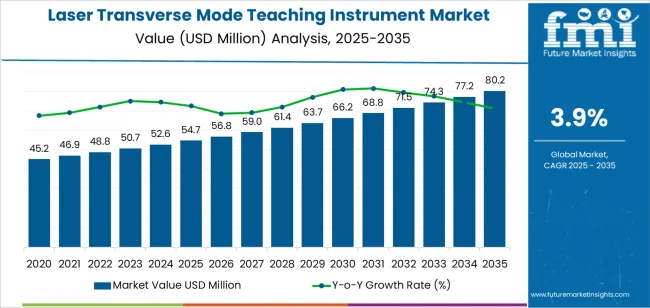
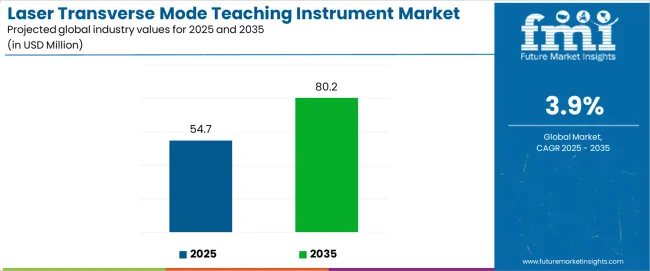
| Metric | Value |
|---|---|
| Estimated Value in (2025E) | USD 54.7 million |
| Forecast Value in (2035F) | USD 80.2 million |
| Forecast CAGR (2025 to 2035) | 3.9 % |
From 2030 to 2035, the market is forecast to grow from USD 66.8 million to USD 80.2 million, adding another USD 13.4 million, which constitutes 52.5% of the ten-year expansion. This period is expected to be characterized by the advancement of digital measurement interfaces, the integration of remote learning capabilities for distance education applications, and the development of comprehensive curriculum packages for enhanced pedagogical effectiveness.
The growing emphasis on educational technology integration and practical learning experiences will drive demand for premium varieties with enhanced connectivity features, improved data analysis tools, and superior educational support characteristics.
Between 2020 and 2024, the laser transverse mode teaching instrument market experienced robust growth, driven by increasing awareness of optical physics education benefits and growing recognition of hands-on learning systems' effectiveness in supporting comprehensive understanding across physics departments and engineering programs. The market developed as institutions recognized the potential for specialized teaching instruments to deliver educational advantages while meeting modern requirements for laboratory-based learning and practical skill development.
Technological advancement in instrument design and educational software began emphasizing the critical importance of maintaining pedagogical effectiveness while extending instrument functionality and improving student learning outcomes across diverse educational applications.
Market expansion is being supported by the increasing global demand for advanced physics education tools and the corresponding shift toward high-performance teaching instruments that can provide superior educational characteristics while meeting institutional requirements for laboratory equipment reliability and cost-effective educational processes. Modern educators are increasingly focused on incorporating instrument systems that can enhance student understanding while satisfying demands for interactive, precisely controlled learning experiences and optimized curriculum integration practices.
Laser transverse mode teaching instruments' proven ability to deliver educational effectiveness, conceptual clarity, and diverse pedagogical possibilities makes them essential components for physics departments and quality-conscious educational institutions.
The growing emphasis on practical education and laboratory-based learning is driving demand for high-performance teaching systems that can support distinctive educational outcomes and comprehensive concept demonstration across optical physics curricula, laser engineering programs, and advanced physics applications. Institutional preference for instruments that combine educational excellence with operational flexibility is creating opportunities for innovative implementations in both traditional and emerging educational applications.
The rising influence of interactive learning methodologies and advanced educational technologies is also contributing to increased adoption of specialized teaching instruments that can provide authentic learning benefits and reliable educational characteristics.
The market is segmented by product type, application, technology platform, educational level, and region. By product type, the market is divided into basic demonstration instruments, interactive virtual simulation systems, advanced measurement platforms, modular teaching kits, and others. Based on application, the market is categorized into colleges and universities, vocational and technical schools, science museums and educational centers, research institutions, and others. By technology platform, the market includes HeNe laser systems, diode laser platforms, fiber laser configurations, and solid-state laser systems. By educational level, the market encompasses undergraduate programs, graduate programs, professional training, and continuing education. Regionally, the market is divided into North America, Europe, Asia Pacific, Latin America, Middle East & Africa, and other regions.
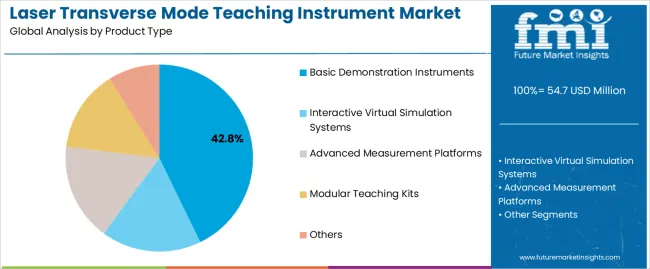
The basic demonstration instruments segment is projected to account for 42.8% of the laser transverse mode teaching instrument market in 2025, reaffirming its position as the leading product category. Educators and physics instructors increasingly utilize basic demonstration instruments for their superior clarity characteristics, established reliability standards, and essential functionality in diverse educational applications across multiple course types. Basic demonstration instruments' proven performance characteristics and established cost-effectiveness directly address institutional requirements for reliable educational tools and optimal concept demonstration in academic applications.
This product segment forms the foundation of modern laser physics education patterns, as it represents the instrument category with the greatest educational impact potential and established compatibility across multiple curriculum systems. Educational investments in fundamental concept demonstration and pedagogical effectiveness continue to strengthen adoption among quality-conscious institutions. With educators prioritizing learning clarity and conceptual understanding, basic demonstration instruments align with both educational objectives and budget requirements, making them the central component of comprehensive physics education strategies.
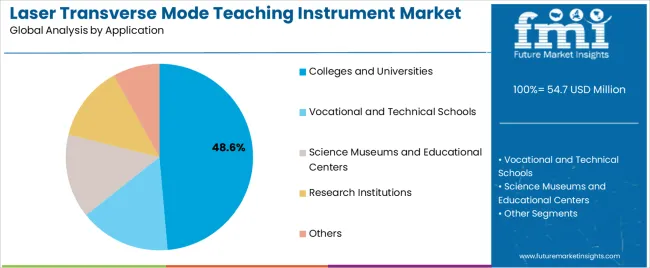
Colleges and universities are projected to represent 48.6% of the laser transverse mode teaching instrument market in 2025, underscoring their critical role as the primary application sector for quality-focused institutions seeking superior educational effectiveness benefits and enhanced learning outcome credentials.
Physics departments and engineering schools prefer university applications for their established student populations, proven educational demand, and ability to maintain exceptional teaching quality while supporting comprehensive curriculum requirements during diverse academic programs. Positioned as essential applications for education-conscious institutions, university offerings provide both pedagogical excellence and academic positioning advantages.
The segment is supported by continuous improvement in educational technology and the widespread availability of established curriculum standards that enable quality assurance and premium positioning at the institutional level. Universities are optimizing instrument selections to support program differentiation and competitive academic strategies. As educational technology continues to advance and institutions seek effective teaching methods, university applications will continue to drive market growth while supporting academic development and student satisfaction strategies.
The laser transverse mode teaching instrument market is advancing rapidly due to increasing physics education consciousness and growing need for hands-on learning solutions that emphasize superior educational outcomes across university segments and technical education applications. The market faces challenges, including competition from simulation software alternatives, equipment maintenance complexities, and instrument cost pressures affecting educational budgets. Innovation in digital integration and advanced measurement capabilities continues to influence market development and expansion patterns.
Expansion of STEM Education and Laboratory Infrastructure
The growing adoption of laser transverse mode teaching instruments in physics programs and engineering education is enabling institutions to develop educational strategies that provide distinctive learning benefits while commanding academic positioning and enhanced student outcome characteristics. Educational applications provide superior concept understanding while allowing more sophisticated demonstration features across various curriculum categories. Educators are increasingly recognizing the pedagogical advantages of instrument positioning for premium educational outcomes and quality-conscious program integration.
Integration of Digital Learning and Virtual Simulation Systems
Modern laser transverse mode teaching instrument manufacturers are incorporating advanced digital interfaces, virtual simulation capabilities, and automated measurement tracking to enhance educational precision, improve learning effectiveness, and meet institutional demands for intelligent teaching solutions. These systems improve educational effectiveness while enabling new applications, including remote learning programs and interactive demonstration protocols. Advanced digital integration also allows educators to support pedagogical leadership positioning and learning outcomes beyond traditional laboratory operations.
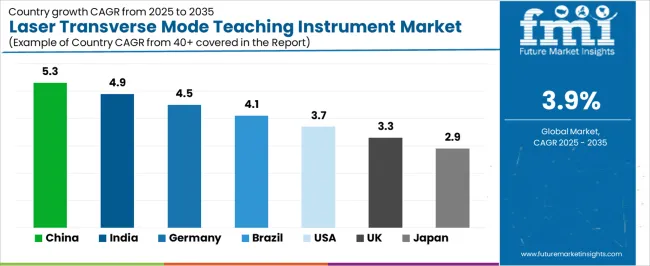
| Country | CAGR (2025 to 2035) |
|---|---|
| China | 5.3% |
| India | 4.9% |
| Germany | 4.5% |
| Brazil | 4.1% |
| USA | 3.7% |
| UK | 3.3% |
| Japan | 2.9% |
The laser transverse mode teaching instrument market is experiencing robust growth globally, with China leading at a 5.3% CAGR through 2035, driven by the expanding higher education sector, growing emphasis on physics education, and increasing adoption of advanced laboratory equipment. India follows at 4.9%, supported by rising enrollment in engineering programs, expanding technical education infrastructure, and growing acceptance of modern teaching methodologies. Germany shows growth at 4.5%, emphasizing established educational excellence and comprehensive optical physics development. Brazil records 4.1%, focusing on educational expansion and institutional modernization growth. The USA demonstrates 3.7% growth, prioritizing advanced educational technologies and laboratory optimization.
The report covers an in-depth analysis of 40+ countries, with top-performing countries are highlighted below.
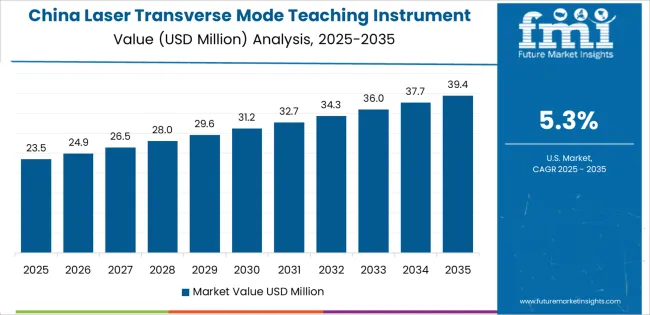
Revenue from laser transverse mode teaching instrument consumption and sales in China is projected to exhibit exceptional growth with a CAGR of 5.3% through 2035, driven by the country's rapidly expanding higher education sector, favorable government policies toward STEM education development, and initiatives promoting advanced physics laboratory equipment across major educational regions. China's position as a leading technology hub and increasing focus on optical engineering education are creating substantial demand for high-quality laser transverse mode teaching instruments in both domestic and international educational markets. Major universities and technical institutes are establishing comprehensive laboratory capabilities to serve growing enrollment and emerging educational opportunities.
Demand for laser transverse mode teaching instrument products in India is expanding at a CAGR of 4.9%, supported by rising educational investment, growing engineering enrollment, and expanding institutional capabilities. The country's developing technical education sector and increasing institutional investment in modern laboratory technologies are driving demand for laser transverse mode teaching instruments across both traditional and advanced educational applications. International equipment companies and domestic distributors are establishing comprehensive operational networks to address growing market demand for quality teaching instruments and effective educational solutions.
Revenue from laser transverse mode teaching instrument products in Germany is projected to grow at a CAGR of 4.5% through 2035, supported by the country's mature educational sector, established physics standards, and leadership in optical technology. Germany's sophisticated academic infrastructure and strong support for advanced educational systems are creating steady demand for both traditional and innovative teaching instrument varieties. Leading equipment manufacturers and specialty distributors are establishing comprehensive operational strategies to serve both domestic markets and growing export opportunities.
Demand for laser transverse mode teaching instrument products in Brazil is anticipated to grow at a CAGR of 4.1% through 2035, driven by the country's emphasis on educational expansion, technical development, and growing institutional capabilities. Brazilian universities and technical schools consistently seek commercial-grade teaching instruments that enhance educational efficiency and support pedagogical excellence for both traditional and modern physics applications. The country's position as a Latin American educational leader continues to drive innovation in specialized teaching applications and academic equipment standards.
Revenue from laser transverse mode teaching instrument products in the USA is expected to expand at a CAGR of 3.7% through 2035, supported by the country's emphasis on educational technology advancement, laboratory optimization, and advanced automation integration requiring efficient teaching solutions. American educators and institutional users prioritize performance reliability and pedagogical precision, making specialized teaching instruments essential components for both traditional and modern educational applications. The country's comprehensive technology leadership and advancing educational patterns support continued market expansion.
Demand for laser transverse mode teaching instrument products in the UK is projected to grow at a CAGR of 3.3% through 2035, supported by established educational standards, mature academic markets, and emphasis on equipment reliability across university and college sectors. British educators and physics professionals prioritize quality performance and pedagogical consistency, creating steady demand for premium teaching instrument solutions. The country's comprehensive market maturity and established educational practices support continued development in specialized applications.
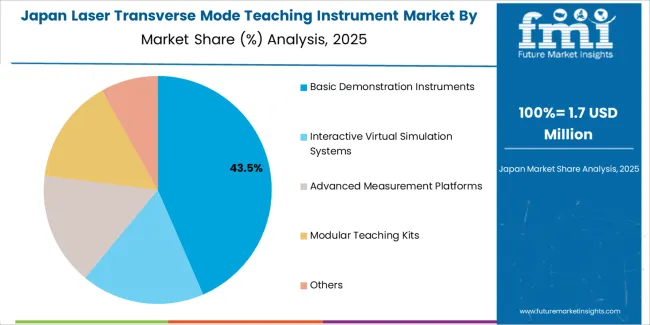
Revenue from laser transverse mode teaching instrument products in Japan is expanding at a CAGR of 2.9% through 2035, supported by the country's emphasis on precision education, quality excellence, and advanced technology integration requiring efficient teaching solutions. Japanese institutions and educational users prioritize technical performance and educational precision, making specialized teaching instruments essential components for both traditional and modern academic applications. The country's comprehensive quality leadership and advancing educational patterns support continued market expansion.
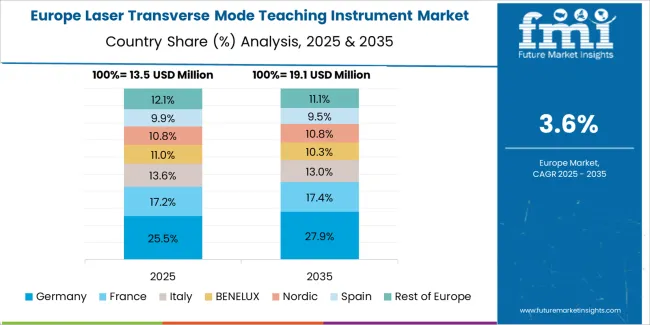
The Europe laser transverse mode teaching instrument market is projected to grow from USD 18.1 million in 2025 to USD 26.4 million by 2035, recording a CAGR of 3.8% over the forecast period. Germany leads the region with a 38.7% share in 2025, moderating slightly to 38.2% by 2035, supported by its strong educational infrastructure and demand for premium, technically advanced physics laboratory equipment. The United Kingdom follows with 22.1% in 2025, easing to 21.6% by 2035, driven by a mature academic market and emphasis on equipment reliability and educational effectiveness.
France accounts for 15.8% in 2025, rising to 16.3% by 2035, reflecting steady adoption of modern teaching technologies and pedagogical innovation enhancement. Italy holds 11.2% in 2025, expanding to 11.8% by 2035 as physics education programs and laboratory modernization grow.
Spain contributes 7.4% in 2025, growing to 7.7% by 2035, supported by expanding higher education sector and equipment modernization. The Nordic countries rise from 3.6% in 2025 to 3.8% by 2035 on the back of strong technology adoption and advanced educational methodologies. BENELUX remains at 1.2% share across both 2025 and 2035, reflecting mature, quality-focused educational markets.
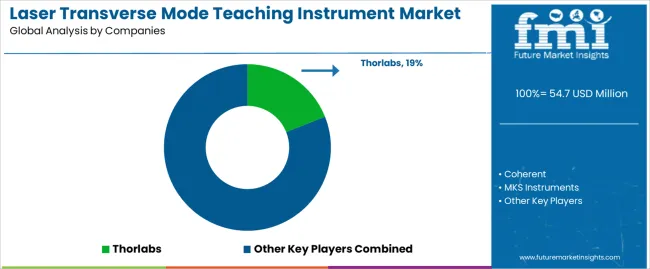
The laser transverse mode teaching instrument market is characterized by competition among established optical equipment manufacturers, specialized educational technology producers, and integrated laboratory solution companies. Companies are investing in precision optics technologies, advanced measurement systems, product innovation capabilities, and comprehensive educational support networks to deliver consistent, high-quality, and reliable laser transverse mode teaching instrument systems. Innovation in measurement accuracy, user interface design, and curriculum-specific product development is central to strengthening market position and educator satisfaction.
Thorlabs leads the market with a strong focus on optical equipment innovation and comprehensive laser transverse mode teaching instrument solutions, offering commercial educational systems with emphasis on manufacturing excellence and technological heritage. Coherent provides specialized laser technologies with a focus on educational market applications and precision engineering networks. MKS Instruments delivers integrated optical solutions with a focus on institutional positioning and educational efficiency. TeachSpin specializes in comprehensive physics teaching instruments with an emphasis on pedagogical applications. Beijing Laser Test Technology focuses on comprehensive educational laser accessories with advanced design and premium positioning capabilities.
The success of laser transverse mode teaching instruments in meeting educational physics demands, educator-driven learning requirements, and pedagogical integration will not only enhance educational quality outcomes but also strengthen global optical equipment manufacturing capabilities. It will consolidate emerging regions' positions as hubs for efficient educational technology production and align advanced economies with modern teaching systems. This calls for a concerted effort by all stakeholders -- governments, industry bodies, manufacturers, distributors, and investors. Each can be a crucial enabler in preparing the market for its next phase of growth.
| Items | Values |
|---|---|
| Quantitative Units (2025) | USD 54.7 m illion |
| Product Type | Basic Demonstration Instruments, Interactive Virtual Simulation Systems, Advanced Measurement Platforms, Modular Teaching Kits, Others |
| Application | Colleges and Universities, Vocational and Technical Schools, Science Museums and Educational Centers, Research Institutions, Others |
| Technology Platform | HeNe Laser Systems, Diode Laser Platforms, Fiber Laser Configurations, Solid-State Laser Systems |
| Educational Level | Undergraduate Programs, Graduate Programs, Professional Training, Continuing Education |
| Regions Covered | North America, Europe, Asia Pacific, Latin America, Middle East & Africa, Other Regions |
| Countries Covered | China, India, Germany, Brazil, United States, United Kingdom, Japan, and 40+ countries |
| Key Companies Profiled | Thorlabs, Coherent, MKS Instruments, TeachSpin, Beijing Laser Test Technology, and other leading laser transverse mode teaching instrument companies |
| Additional Attributes | Dollar sales by product type, application, technology platform, educational level, and region; regional demand trends, competitive landscape, technological advancements in optical engineering, precision measurement initiatives, educational effectiveness programs, and premium product development strategies |
The global laser transverse mode teaching instrument market is estimated to be valued at USD 54.7 million in 2025.
The market size for the laser transverse mode teaching instrument market is projected to reach USD 80.2 million by 2035.
The laser transverse mode teaching instrument market is expected to grow at a 3.9% CAGR between 2025 and 2035.
The key product types in laser transverse mode teaching instrument market are basic demonstration instruments , interactive virtual simulation systems, advanced measurement platforms, modular teaching kits and others.
In terms of application, colleges and universities segment to command 48.6% share in the laser transverse mode teaching instrument market in 2025.






Full Research Suite comprises of:
Market outlook & trends analysis
Interviews & case studies
Strategic recommendations
Vendor profiles & capabilities analysis
5-year forecasts
8 regions and 60+ country-level data splits
Market segment data splits
12 months of continuous data updates
DELIVERED AS:
PDF EXCEL ONLINE
Laser Welding Equipment Market Forecast and Outlook 2025 to 2035
Laser Welding Market Size and Share Forecast Outlook 2025 to 2035
Laser Ablation Systems Market Size and Share Forecast Outlook 2025 to 2035
Laser Measurement Integrating Sphere Market Size and Share Forecast Outlook 2025 to 2035
Laser Safety Cloths Market Size and Share Forecast Outlook 2025 to 2035
Laser Dazzler Market Size and Share Forecast Outlook 2025 to 2035
Laser Cable Marking Market Size and Share Forecast Outlook 2025 to 2035
Laser Cladding Market Size and Share Forecast Outlook 2025 to 2035
Laser Marking Equipment Market Size and Share Forecast Outlook 2025 to 2035
Laser Cutting Machines Market Size and Share Forecast Outlook 2025 to 2035
Laser Wire Marking Systems Market Size and Share Forecast Outlook 2025 to 2035
Laser Photomask Market Size and Share Forecast Outlook 2025 to 2035
Laser Welding Machine Market Size and Share Forecast Outlook 2025 to 2035
Laser Technology Market Size and Share Forecast Outlook 2025 to 2035
Laser Interferometer Market Size and Share Forecast Outlook 2025 to 2035
The Laser Therapy Devices Market is segmented by Device Type and End User from 2025 to 2035
Laser Safety Glasses Market Growth – Trends & Forecast 2025 to 2035
LASER Light Cables Market Growth – Trends & Forecast 2025 to 2035
Laser Trackers Market - Growth, Demand & Forecast 2025 to 2035
Laser Projection Market Analysis & Forecast by Product Type, Vertical, and Region through 2025 to 2035

Thank you!
You will receive an email from our Business Development Manager. Please be sure to check your SPAM/JUNK folder too.
Chat With
MaRIA